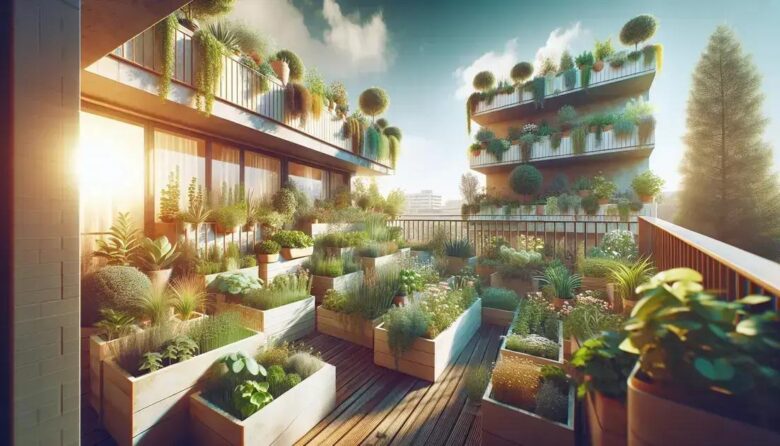Permaculture is not just for big farms. If you’ve got an urban balcony, you can create a thriving oasis using container beds. Imagine stepping outside to pick fresh herbs or veggies, right from your balcony! Intrigued? Let’s dive into how you can transform limited space into a sustainable garden.
how to start your permaculture journey
Starting your permaculture journey on an urban balcony can be both rewarding and practical. Begin by observing your space and understanding the natural elements such as sunlight, wind, and rain patterns. Assess where sunlight falls during the day and consider how to leverage it.
Next, plan your layout. Use a mix of containers to maximize space; vertical gardening and hanging planters can add dimension. Look for durable, lightweight materials ideal for balconies. You can start building soil by composting kitchen scraps or sourcing organic compost.
Consider water management. Use self-watering pots for consistent moisture and install rainwater collection systems if possible. Efficient water usage will ensure your plants thrive.
Finally, begin with easy-to-grow plants. Herbs like basil, parsley, and mint are great for beginners. As you gain confidence, incorporate more diverse species and experiment with permaculture techniques, like companion planting, to optimize growth.
Your journey into permaculture involves continuous learning and adaptation. Be patient, observe what works, and enjoy the process of cultivating your green space.
choosing the best containers for balcony gardens
Selecting the right containers is crucial for successful balcony gardens. Start by assessing the space you have. Consider smaller pots for herbs and larger ones for vegetables like tomatoes or peppers. Look for containers with good drainage holes to prevent root rot.
Material matters when choosing containers. Plastic and fiberglass options are lightweight and retain moisture, making them ideal for balconies. Terracotta pots are porous, allowing plants to breathe but may dry out faster, requiring more frequent watering.
Shape and size play pivotal roles in container selection. Opt for deeper containers for root vegetables and shallower, wide ones for leafy greens that benefit from spreading out. Experiment with vertical or stackable containers if horizontal space is limited.
Consider decorative elements too. Containers with appealing aesthetics can enhance your balcony’s visual appeal. Incorporate a mix of colors and textures, using painted or uniquely shaped pots to create an engaging environment.
Finally, think about mobility. Choose containers that are easy to move if you plan to adjust plant positions based on sunlight exposure or seasonal weather changes. This flexibility can help optimize your plant’s growth conditions year-round.
essential plants for urban permaculture
For a successful urban permaculture garden, choose plants that thrive in small spaces and offer multiple benefits. Start with herbs like basil, mint, and parsley. These require less space and provide a continuous harvest for culinary use.
Leafy greens such as lettuce, kale, and spinach are excellent choices. They grow quickly and can be harvested progressively. You can plant them in shallow containers, as they don’t require deep soil.
Add color and nutrition with compact fruiting plants like cherry tomatoes or dwarf peppers. These deliver high yields in limited space. Choose varieties bred for container growth to maximize productivity.
Consider legumes like peas and beans. They enrich the soil by fixing nitrogen and serve as vertical elements, using space efficiently.
Edible flowers like nasturtiums and marigolds not only beautify your balcony but also attract pollinators and serve as companion plants, improving ecosystem health.
Diversify with aromatic plants like lavender or rosemary. These can deter pests and add fragrance, making the garden more enjoyable. Choose species that match your local climate for better success.
water management strategies in small spaces
Effective water management is crucial for small spaces like urban balconies. Begin by choosing self-watering pots or planters. These containers have a built-in reservoir, keeping plants hydrated longer without frequent watering.
Consider installing a drip irrigation system. These systems deliver water directly to the plant roots, minimizing waste and ensuring consistent moisture. They’re easy to set up and can be automated with timers.
Use mulch to conserve moisture. Adding a layer of organic material such as straw or wood chips on top of the soil reduces evaporation, helps retain soil moisture, and adds nutrients as it breaks down.
Collect rainwater using a small rain barrel or bucket. Position them to catch runoff water from a roof or balcony edge. Rainwater is free and often healthier for plants than tap water, as it’s free of chemicals found in treated water.
Make sure to choose plants that are drought-tolerant, particularly if water access is limited. Succulents and Mediterranean herbs like rosemary or lavender require less water, reducing overall usage.
By implementing these strategies, you can create a sustainable and efficient watering system that supports a thriving balcony garden.
integrating wildlife habitats in urban gardens
To enhance your urban garden’s ecosystem, consider integrating wildlife habitats. Begin by adding bird feeders to attract a variety of birds. Choose feeders that accommodate different species, providing a mix of seeds.
Create a bee-friendly environment by planting flowers rich in nectar. Lavender, sunflowers, and wildflowers can attract bees and other pollinators. These plants improve pollination and add color to your garden.
Introduce a water source like a small birdbath or shallow bowl. Regularly filled, these water features attract birds and insects, providing essential hydration and encouraging pollinators to visit your garden.
Place a few bug hotels to encourage beneficial insects. These structures can be made from natural materials like bamboo, sticks, and logs, providing shelter and breeding spaces.
Incorporate native plants to support local wildlife. These plants are well-suited to the environment and attract the fauna adapted to your region’s ecosystem.
Providing shelter with shrubs or small trees can offer protection and nesting sites for birds. By integrating these elements, your urban garden can become a flourishing wildlife habitat.
mistakes to avoid in urban permaculture
When engaging in urban permaculture, it’s easy to make mistakes that can hinder success. One common error is overcrowding plants. Each species needs space for roots and foliage, so ensure proper spacing to prevent competition for resources.
Another issue is selecting non-native plants. These may struggle with local climates or compete with native species. Focus on selecting plants suited to your environment to support both growth and local wildlife.
Overwatering is a frequent mistake on balconies. Many urban gardeners tend to overestimate water needs. Avoid this by using plants that are water-efficient and adopting smart irrigation practices, like self-watering pots.
Neglecting soil health can also lead to problems. Use quality organic compost and regularly replenish soil nutrients to keep it rich and well-draining.
Failing to plan for sunlight exposure can impact plant health. Observe how light moves across your balcony and arrange plants according to their light requirements to give them the best chance at thriving.
Finally, ignoring pest management can allow infestations to grow. Introduce beneficial insects like ladybugs or use natural deterrents to maintain a balanced ecosystem.
Embracing urban permaculture
Urban permaculture offers a fantastic way to transform small spaces into thriving gardens that support sustainability and biodiversity. By choosing suitable plants, practicing effective water management, and integrating wildlife habitats, you can create a vibrant green oasis right on your balcony.
Avoiding common mistakes, such as overcrowding and improper spacing, ensures that your plants receive the resources they need to flourish. Thoughtful planning around sunlight exposure and pest management will further enhance your garden’s health.
Whether you’re a beginner or experienced gardener, these strategies can help you build a productive urban garden. While challenges may arise, the rewards of nurturing plants and watching your garden evolve make the effort worthwhile. Start your urban permaculture journey today and enjoy the benefits of growing your own food and fostering a mini ecosystem at home.
FAQ – Frequently Asked Questions about Urban Permaculture on Balconies
What is urban permaculture?
Urban permaculture is the practice of applying permaculture principles in city settings. It’s about creating sustainable, self-sufficient ecosystems using available space efficiently, like on balconies.
How can I start a permaculture garden on my balcony?
Begin by assessing sunlight and space. Choose plants suited to your conditions and use containers effectively. Start with easy-to-grow herbs and greens.
What are the benefits of integrating wildlife habitats in my garden?
Integrating wildlife habitats attracts beneficial insects and pollinators, enhancing biodiversity and aiding plant health while contributing to a balanced ecosystem.
How do I manage water efficiently in a small garden?
Use self-watering pots, drip irrigation systems, and collect rainwater where possible. Apply mulch to retain moisture and choose plants with water needs that match your environment.
Which plants are ideal for small urban gardens?
Opt for compact and versatile plants like herbs, lettuce, cherry tomatoes, and edible flowers. These thrive well in containers and often provide continual harvests.
What common mistakes should I avoid in urban permaculture?
Avoid overcrowding, neglecting soil health, and choosing non-native species. Plan for adequate sunlight, and manage pests naturally to maintain garden balance.



